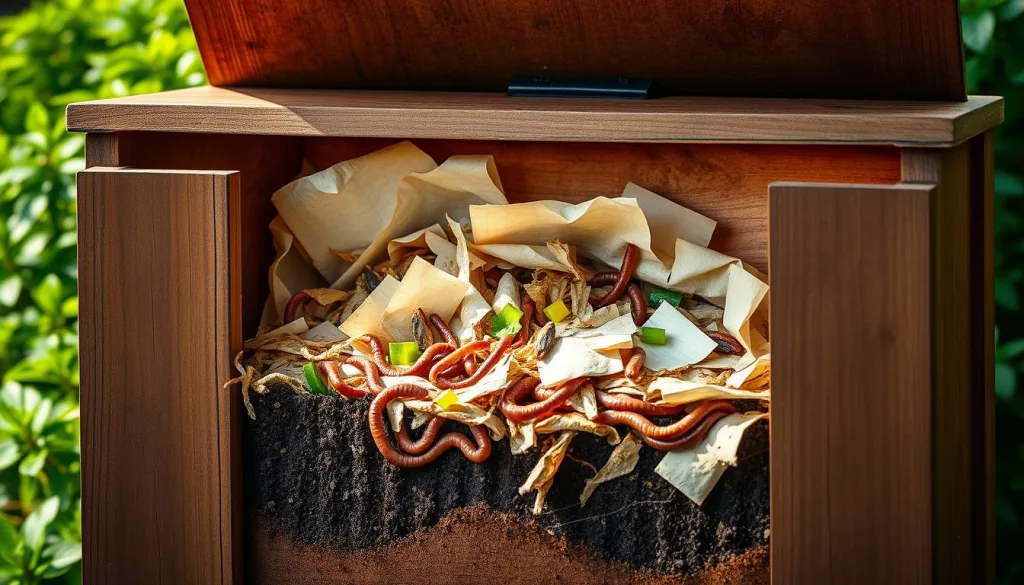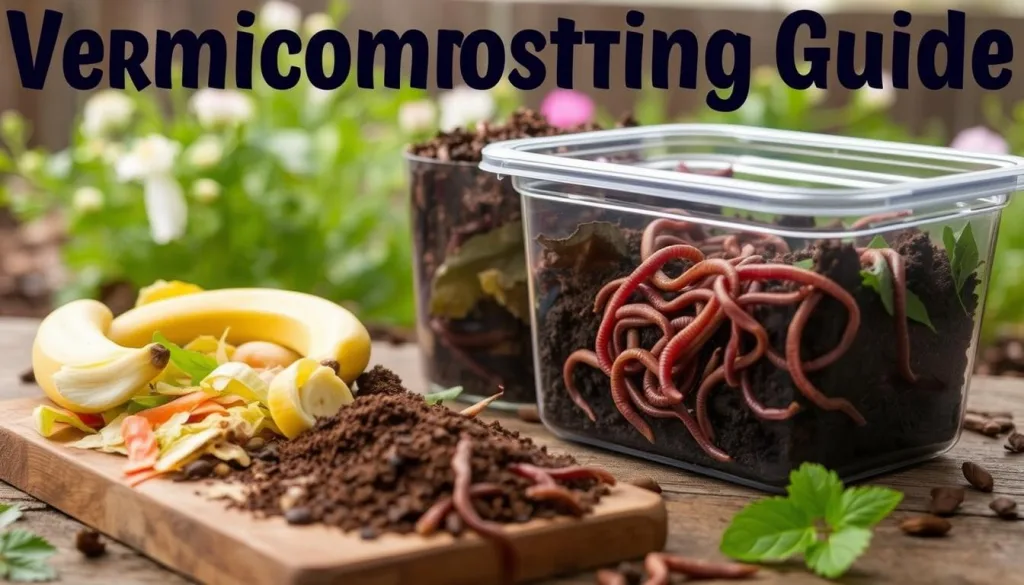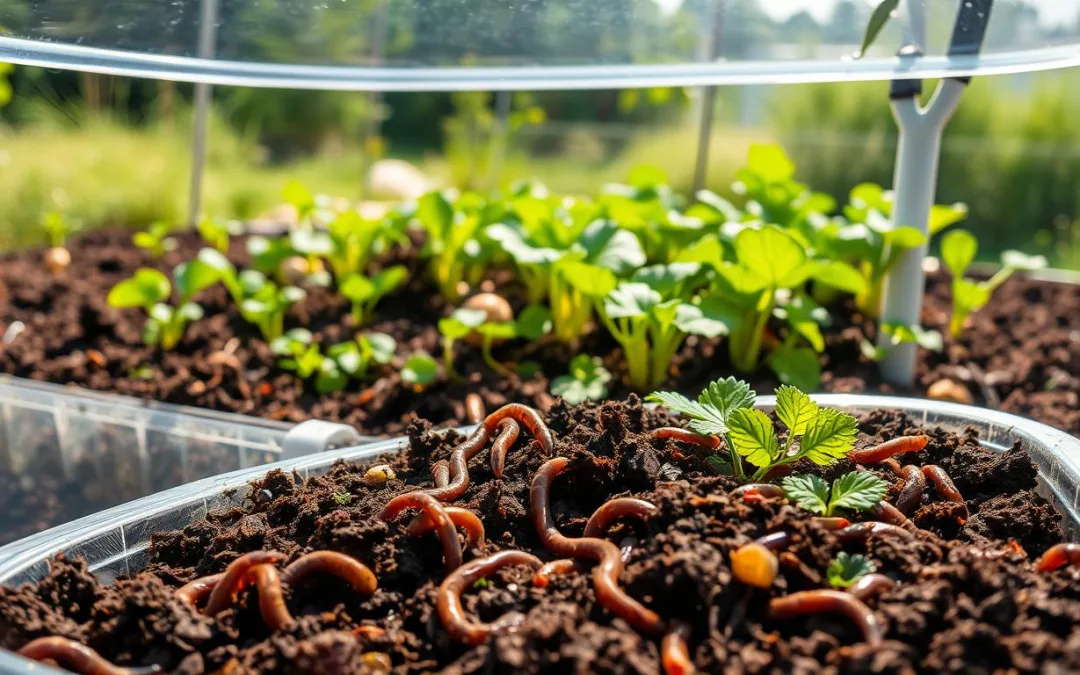Vermicomposting is a new way to tackle our waste problems. Every year, we throw away 38 billion tons of organic waste. This method turns kitchen scraps and plant waste into fertilizer, thanks to earthworms.
This method does more than just reduce waste. It turns waste into “black gold,” a fertilizer that’s full of nutrients. This helps plants grow and is good for the environment.
It also cuts down on food waste in landfills. Landfills get nearly 25% of U.S. waste. Vermicomposting is better for the planet and makes a better fertilizer than regular composting.
Key Takeaways
- Transforms 38 billion tons of global organic waste annually
- Produces nutrient-rich “black gold” fertilizer
- Reduces landfill waste and greenhouse gas emissions
- Works with over 4,000 earthworm species
- Creates an affordable home waste management solution
Understanding Vermicomposting: Nature’s Recycling Process
Vermicomposting is a cool way to deal with waste. It turns old materials into soil that’s full of nutrients. This method uses worms to break down waste, making it a top natural recycling system.
The Science Behind Worm Composting
At its heart, vermicomposting is about worms eating waste. They then turn it into compost that’s full of good stuff. This process is great because worms can make a lot of compost from waste, helping to cut down on landfill size.
Types of Worms Used in Vermicomposting
Not all worms are good for composting. The right kind is key. Here are the main types:
- Epigeic Worms: These worms live on the surface and love organic waste.
- Anecic Worms: They dig deep tunnels in the soil.
- Endogeic Worms: These worms burrow horizontally in the soil.
Basic Components of a Vermicomposting System
| Component | Function | Ideal Characteristics |
|---|---|---|
| Worm Bin | Housing for worms | Well-ventilated, dark, moisture-resistant |
| Bedding | Habitat and food source | Shredded paper, cardboard, coconut coir |
| Worm Species | Primary decomposers | Red wigglers (Eisenia Fetida) recommended |
Knowing these basics helps people use vermicomposting to manage waste better. It’s a green way to recycle.
Benefits of Vermicomposting for Your Garden and Environment
Vermicomposting is great for your garden and the planet. It turns waste into a natural fertilizer that changes your garden for the better.
The benefits for soil are amazing. Worm castings have seven times more nitrogen than regular soil. This makes the soil better for plants, improving its structure and nutrients.
Worm castings also make the soil better for plants. They help the soil breathe, hold water, and drain well. This creates a perfect place for plant roots to grow.
- Increases soil organic matter
- Improves water retention capabilities
- Provides essential micronutrients
- Introduces beneficial microorganisms
Vermicomposting does more than just feed plants. The special mix of microbes in worm castings helps plants fight off diseases and grow faster.
- Suppress plant diseases
- Boost plant immune systems
- Accelerate plant growth rates
- Enhance overall plant resilience
Vermicomposting turns up to 60% of waste into a valuable fertilizer. It’s good for gardeners and the planet. It cuts down on landfill waste and makes soil rich in nutrients for plants.
Vermicomposting: Nature’s most efficient recycling system for organic waste and plant nutrition.
Creating Nutrient-Rich Soil with Worm Castings
Vermicomposting is a new way to make soil better. It turns waste into a nutrient-rich soil amendment. This method is better than regular composting.
Essential Nutrients in Vermicompost
Worm castings are full of nutrients that help plants grow strong. They have minerals that plants need to grow well:
- Nitrates
- Potassium
- Magnesium
- Calcium
- Phosphorus
Comparing Vermicompost to Traditional Compost
Vermicompost is better for the environment than regular compost. It gives plants nutrients right away. This helps plants grow faster.
| Characteristic | Vermicompost | Traditional Compost |
|---|---|---|
| Nutrient Absorption | Immediate | Requires Breakdown Time |
| Microbiological Activity | High | Moderate |
| Nutrient Concentration | Higher | Lower |
Impact on Plant Growth and Health
Vermicomposting makes plants healthier. The worm castings make the soil better in many ways:
- Improves water retention
- Introduces beneficial microbes
- Neutralizes soil pH
- Provides natural pest resistance
Pro tip: For mature plants, apply approximately 1 square inch of worm castings per 2-3 inches of plant height to maximize growth.
Setting Up Your First Vermicomposting Bin

Starting a vermicomposting bin is a great way to recycle organic waste. It’s not just about managing waste. It’s a sustainable choice for gardeners and those who care about the environment.
When you set up your first worm bin, keep these points in mind:
- Choose a well-ventilated container with drainage holes
- Select a location with stable temperatures between 55-80°F
- Prepare appropriate bedding materials
- Ensure proper moisture levels
Your worm bin needs to be a cozy home for your composting friends. Red worms do best in the top 6-8 inches of bin material. So, depth and the quality of bedding are key to success.
| Bin Size | Worm Population | Daily Food Waste |
|---|---|---|
| 2 x 2 feet | 1 pound | 0.5 pounds (2-person household) |
| 3 x 3 feet | 2 pounds | 1 pound (4-person household) |
To get the most out of vermicomposting, keep things consistent. Worms can eat 100-200% of their body weight each week. This turns waste into compost full of nutrients. A well-set-up bin can start a microbial ecosystem in days, making waste recycling efficient.
Remember: A healthy worm bin should smell earthy and show active reproduction – signs of a thriving composting environment.
Optimal Conditions for Successful Vermicomposting
To make worm composting work, you need to pay attention to several things. The right conditions help worms stay healthy and break down waste well.
Temperature and Moisture Management
For the best results, keep the temperature between 55-85°F. Worms do best in a steady, moist environment. Aim for 80-90% moisture to help them breathe and work.
- Ideal temperature range: 55-85°F
- Optimal moisture content: 80-90%
- Acceptable pH range: 5-9
Ventilation and Location Strategies
Good airflow is key for worm composting. Your bin should have many holes, mainly at the bottom and middle. Pick a spot that keeps worms safe from too much heat or sun.
| Location Criteria | Recommended Conditions |
|---|---|
| Temperature Protection | Consistent 55-85°F environment |
| Sunlight Exposure | Indirect, moderate light |
| Ventilation | Multiple air holes |
Bedding and Nutrition
Choose bedding that’s good for structure and food. Carbon-rich materials like shredded cardboard, newspaper, and dried leaves are perfect. Keep a mix of 70% green and 30% brown waste for the best compost.
“A well-managed worm bin is a living ecosystem that transforms waste into nutrient-rich soil amendment.” – Composting Expert
By following these tips, you’ll have a worm composting system that works great. It turns waste into valuable soil.
What to Feed Your Worms: Best Practices and Tips

Knowing what to feed your worms is key for good vermicomposting. The right food keeps worms healthy and boosts soil benefits. Red wiggler worms love certain organic foods that turn kitchen waste into compost.
For the best results, use a mix of foods. Experts say to mix 70% green stuff with 30% brown. This mix helps worms make great compost for your garden.
Worm-Friendly Food Choices
- Fruit and vegetable scraps (avoid citrus)
- Coffee grounds and tea bags
- Shredded cardboard and paper
- Crushed eggshells
- Fallen leaves
Foods to Avoid
- Meat and dairy products
- Oily or fatty substances
- Spicy foods
- Processed foods
- Chemically treated materials
Tip: Cut or blend food scraps to help worms eat them quicker. Freezing food waste before adding it can stop fruit flies and speed up breakdown.
Remember, a well-managed worm bin can double its population every two months!
By sticking to these tips, you’ll have a worm bin that turns waste into garden gold.
Common Challenges and Solutions in Vermicomposting
Vermicomposting is rewarding but comes with challenges. Knowing these issues and their fixes is vital for a healthy worm composting ecosystem.
Troubleshooting Common Vermicomposting Issues
Maximizing worm composting benefits means tackling common problems fast. Issues often arise from environment and feeding.
- Moisture Management: Too much or too little moisture harms worms. Aim for 70% to 85% moisture.
- Odor Control: Bad smells mean too much food or wrong food coverage.
- Pest Prevention: Fruit flies and pests are kept away by covering food well.
Maintaining a Healthy Worm Population
For plants to benefit, worms must thrive. Important steps include:
- Check worm numbers regularly
- Keep pH at 7, neutral
- Temperature should be 65°F to 85°F
Preventing Odors and Pests
To succeed in vermicomposting, manage well. Cover food, avoid overfeeding, and ensure air flow for worms.
Remember: A well-maintained worm bin can last forever with the right care and food.
Harvesting and Using Your Vermicompost
Harvesting vermicompost is key to understanding its benefits for your garden. Your worm bin is ready after 3-4 months of composting. The compost is dark, crumbly, and feels like fine coffee grounds.
Use light migration techniques to move worms away from the compost. This makes it easier to separate them.
Check your compost for signs of maturity. It should be light, fluffy, and dark. This means it’s full of nutrients.
Worm castings are packed with nutrients, up to 5 times more than regular soil. They’re great for vegetable gardens, potted plants, and landscapes.
After harvesting, add two handfuls of compost back into the bin. This keeps the microbes active. You can use vermicompost as a potting mix, soil dressing, or make a liquid fertilizer.
This way, you turn kitchen waste into a valuable garden resource. It’s a win for your garden and the environment.
FAQ
What exactly is vermicomposting?
What types of worms are best for vermicomposting?
What can I feed my worms?
How long does it take to produce vermicompost?
Can I do vermicomposting in an apartment?
What are the main benefits of vermicomposting?
How do I know if my worm bin is healthy?
What common problems might I encounter in vermicomposting?
How do I harvest vermicompost?
Is vermicomposting better than traditional composting?
Source Links
- Surprising Advantages of Using Earthworms to Get Rid of Our Waste – https://medium.com/the-environment/surprising-advantages-of-using-earthworms-to-get-rid-of-our-waste-3c2a2c17661b
- Vermicompost Almost Guarantees A Thriving Garden: Here’s How To Get It – https://www.mindbodygreen.com/articles/vermicomposting?srsltid=AfmBOoob329g3GFGAAg6iQplIlf27bpf-SWy2pkvV-9Aqi8sQtF_uWEp
- Advantages of Vermicompost – Iowa Worm Composting – https://www.iowawormcomposting.com/advantages-of-vermicompost/
- Composting vs. Recycling: Understanding the Differences – https://www.ecoversity.org/blog/composting-vs-recycling
- Vermicompost: Organic, Eco-Friendly Ultimate Fertilizer – https://www.abhijeetshirke.in/vermicompost-organic-farming/
- Vermicomposting – https://composting.ces.ncsu.edu/vermicomposting-2/
- Benefits Of Vermicomposting and Why It’s The Future – https://blog.mywastesolution.com/benefits-of-vermicomposting-and-why-its-the-future/
- Benefits of Vermicomposting – https://www.vegogarden.com/blogs/academy/benefits-of-vermicomposting
- The Benefits of Worm Castings on Garden Soil and Plants – https://unclejimswormfarm.com/the-effectiveness-of-worm-castings-on-garden-soil-and-plants/?srsltid=AfmBOoriZU8YRgjAvYRHprLuNelVYMshfqzf5ZmVjIzjhZ5KNDYa5UZh
- Vermicomposting: The Complete Guide to Worm Castings – Garden Therapy – https://gardentherapy.ca/worm-castings/
- Using Worm Castings – AS Department of Public Worms (DPW) – https://worms.as.ucsb.edu/vermicomposting-using-worm-castings/
- How to Start a Worm Bin the Right Way: Vermicomposting 101 – https://urbanwormcompany.com/how-to-start-worm-bin/
- Vermicomposting: How to Set Up a Worm Bin – https://www.thespruce.com/vermicomposting-setting-up-a-worm-bin-2539503
- Vermicomposting: The Ultimate Guide for the Beginner and Beyond – https://urbanwormcompany.com/vermicomposting-ultimate-guide-beginner-expert/
- Vermicomposting for Beginners – Rodale Institute – https://rodaleinstitute.org/science/articles/vermicomposting-for-beginners/
- Vermicomposting: An Effective Option for Recycling Organic Wastes – https://www.intechopen.com/chapters/71592
- What Do Worms Eat? A Road Map for What To Feed Your Worms – https://urbanwormcompany.com/what-do-worms-eat/
- Vermicomposting: How to Use Worms to Make Compost – https://sunnysimpleliving.com/vermicomposting/
- Worm Composting: Common Problems and Solutions – – https://www.everchangeproductions.co/worm-composting-common-problems-and-solutions/
- The Basics of Vermicomposting – Oklahoma State University – https://extension.okstate.edu/fact-sheets/the-basics-of-vermicomposting.html
- Harvesting My Vermicompost – Red Worm Composting – https://www.redwormcomposting.com/worm-castings/harvesting-my-vermicompost/
- How to Create and Use Vermicompost – https://yardandgarden.extension.iastate.edu/how-to/how-create-and-use-vermicompost


